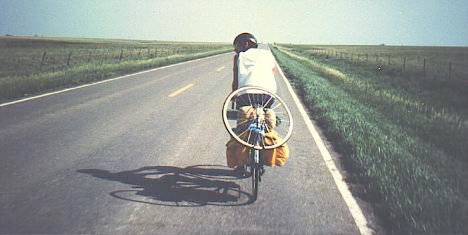
One of the many ways that the Adventure Cycling Association raises funds for its non-profit activities is to ask members to sponsor a one-mile stretch of a bicycle route.
For $200 (more for a mountain pass), you can dedicate a mile on one of several bicycle maps: TransAmerica, Pacific Coast, Lewis & Clark, or Great Divide Mountain Bike Route. Map panels or entire maps are available too.
My friend Bruce and I rode the TransAmerica bike route from Yorktown, Virginia, to Pueblo, Colorado in 1984. Then we picked our way over a few other bike routes to Carlsbad, California. The 1984 bike tour journal is on my website.
Reading about that offer in an email I received Tuesday, I started thinking about which mile of the TransAmerica Bicycle Route I would choose to sponsor.
How to choose
Would I choose a mile based on people we met along the way? Memorable scenery? A major one-day accomplishment? Or something else.
I can check online for which TransAmerica miles are purchased. I see that 177 miles on the 4,262-mile bicycle route have been spoken for. That leaves me with lots of opportunites. (Interestingly, most of the dedicated miles are in the western US.)
How about that mile on Afton Mountain, Virginia, where the Cookie Lady's Bike House is located? Taken.
How about Berea where a couple stepped out of the crowd watching the passing of the Olympic Torch and offered us a place for the night? Taken.
Lazy Louie's place is somewhere between Hartville and Marshfield, Missouri, but I'm not sure which mile is his place (we made the trip without bike computers, an expensive extravagance at the time). Anyway, read what someone wrote about dedicating a mile in Marshfield:
“To commemorate surviving the worst storm of the trip with Jeff & Anne Katherine, Paul & Annemeika, and Sid and the many wonderful miles that followed. “
Kansas
Now I'm thinking maybe Chanute, Kansas, where Bruce and I were brought together by Bryan and Janette after bizarrely becoming separated about 10 miles from town. Then I start thinking about the chain of events that “rescue” created.
Bryan is a local cyclist and he suggests we bypass a piece of nasty gravel road by riding off the bike route to US Highway 54 into El Dorado. Bruce and I are always happy to skip gravel, so we follow his directions the next morning.
I don't know the condition of US 54 now, but in 1984 it's a busy two-lane highway with no shoulder. A wind blowing from the south as we ride west forces us to bear to the left to keep a straight course. That's a problem whenever a truck passes that blocks the wind and we veer toward it.
Oil trucks
Worse than all the cars, pickups and 18-wheelers on this route are the oil trucks heading to the Getty refinery in El Dorado. The crazed, benzedrine-addled drivers push on without yielding to us, passing extremely close whenever an oncoming truck keeps them in the lane. I suppose slowing down is not a factor. Or maybe they're playing a game to see how close they can get.
With my eyes are riveted to the white line at the edge of the road, an oil tanker passes so close I can feel the heat from its wheels on my left arm. He passes, then I hear the brakes of the tanker following him. I look up and there's Bruce in the road with his bicycle tipped over.
It all happens so fast we can't reconstruct it. Bruce thinks the truck might have brushed him or he went off the road then flipped when he tried to get back on. In any case, there are some scrapes, Bruce's front wheel is tacoed, and for a few minutes I'm thinking our cross-country trip has come to an end.
The mile
We spent the night in the unlikely named El Dorado, in a small motel near the refinery. Bruce can't find anyone to repair his aluminim rim, so he buys a steel rim, lashes the bad one to his rack, and we take off the next morning.
We head straight up the road to the nearest location that intersects the TransAmerica bike route. We eventually reach it somewhere around Newton. Here's what I wrote in my journal about reaching County Road 80 on the bike route:
“It was like being delivered back to a slower way of life. Traffic virtually disappeared and I could hear birds singing from the perches on fenceposts. The tension left my body. Our road was flat and straight. We could see trees, towns, and grain elevators on the horizon and pedal for an hour before we reached them.”
I was extremely relieved to be back on the TransAm. I also was relieved we were still heading west, as that encounter on US 54 could have ended our adventure.
So if I ever have the $200 to sponsor a mile, it would be that mile in Kansas where we picked up the TransAmerica bike route again. It was like returning home after a bad experience. And I felt we had a clear route all the way to California.

Recent Comments